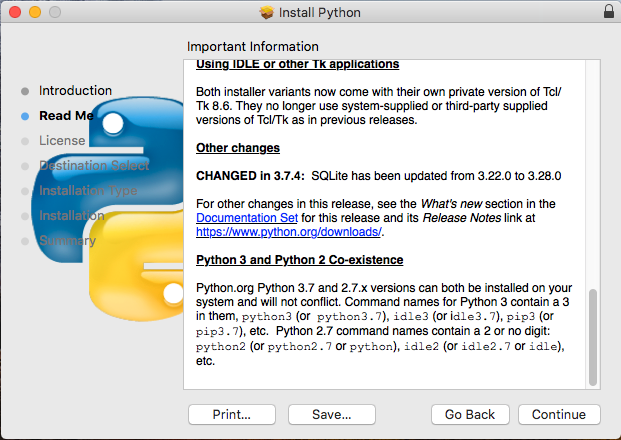- Install pip mac python 3; os.execl; how to generate python code; pytest; how to know if i'm in a virtual environment; ubuntu cant find python installation; how to install python 3 on ubuntu 20.04; The Python 2 bindings for rpm are needed for this module. If you require Python 3 support use the `dnf` Ansible module instead.
- Gpg -verify Python-3.6.2.tgz.asc Note that you must use the name of the signature file, and you should use the one that's appropriate to the download you're verifying. (These instructions are geared to GnuPG and Unix command-line users.).
Command - pip install psycopg2 (for python 3) Command - pip3 install psycopg2 (for python 2) Although, if it does not work there is one more way as well using the.whl(wheel file) using the wheel - pip install and from here you can download.whl file. Pip install your.whl Download the wheel file taking the version of your python in mind.
TensorFlow 2 packages are available
tensorflow—Latest stable release with CPU and GPU support(Ubuntu and Windows)tf-nightly—Preview build (unstable). Ubuntu and Windows include GPU support.
Older versions of TensorFlow
For TensorFlow 1.x, CPU and GPU packages are separate:

tensorflow1.15—Release for CPU-onlytensorflow-gpu1.15—Release with GPU support(Ubuntu and Windows)
System requirements
- Python 3.6–3.8
- Python 3.8 support requires TensorFlow 2.2 or later.
- pip 19.0 or later (requires
manylinux2010support) - Ubuntu 16.04 or later (64-bit)
- macOS 10.12.6 (Sierra) or later (64-bit) (no GPU support)
- Windows 7 or later (64-bit)
- Raspbian 9.0 or later
- GPU support requires a CUDA®-enabled card (Ubuntu and Windows)
pip.Hardware requirements
- Starting with TensorFlow 1.6, binaries use AVX instructions which may not run on older CPUs.
- Read the GPU support guide to set up a CUDA®-enabled GPU card on Ubuntu or Windows.
1. Install the Python development environment on your system
Check if your Python environment is already configured:
Requires Python 3.6–3.8, pip and venv >= 19.0 If these packages are already installed, skip to the next step.
Otherwise, install Python, the pip package manager, and venv:
Ubuntu
macOS
Install using the Homebrew package manager:
Windows
Install the Microsoft Visual C++ Redistributable for Visual Studio 2015, 2017, and 2019. Starting with the TensorFlow 2.1.0 version, the msvcp140_1.dll file is required from this package (which may not be provided from older redistributable packages). The redistributable comes with Visual Studio 2019 but can be installed separately:

- Go to the Microsoft Visual C++ downloads,
- Scroll down the page to the Visual Studio 2015, 2017 and 2019 section.
- Download and install the Microsoft Visual C++ Redistributable for Visual Studio 2015, 2017 and 2019 for your platform.
Make sure long paths are enabled on Windows.
Install the 64-bitPython 3 release for Windows (select pip as an optional feature).
Raspberry Pi
Requirements for the Raspbian operating system:
Other
Install Python 3 Mac
Upgrading the system pip can cause problems.
can cause problems.If not in a virtual environment, use
python3 -m pip for the commands below. This ensures that you upgrade and use the Python pip instead of the system pip.2. Create a virtual environment (recommended)
Python virtual environments are used to isolate package installation from the system.
Ubuntu / macOS
Create a new virtual environment by choosing a Python interpreter and making a ./venv directory to hold it:
Activate the virtual environment using a shell-specific command:
When the virtual environment is active, your shell prompt is prefixed with (venv).
Install packages within a virtual environment without affecting the host system setup. Start by upgrading pip:
And to exit the virtual environment later:
Windows
Create a new virtual environment by choosing a Python interpreter and making a .venv directory to hold it:
Activate the virtual environment:
Install packages within a virtual environment without affecting the host system setup. Start by upgrading pip:
And to exit the virtual environment later:
Conda
While the TensorFlow provided pip package is recommended, acommunity-supportedAnaconda packageis available. To install, read the Anaconda TensorFlow guide.
3. Install the TensorFlow pip package
Install Python 3 Mac Catalina
Choose one of the following TensorFlow packages to install from PyPI:
tensorflow—Latest stable release with CPU and GPU support(Ubuntu and Windows).tf-nightly—Preview build (unstable). Ubuntu and Windows include GPU support.tensorflow1.15—The final version of TensorFlow 1.x.
setup.py file under REQUIRED_PACKAGES.Virtual environment install
Install Python 3 Mac Os
Verify the install:
System install
Verify the install:
Success: If a tensor is returned, you've installed TensorFlow successfully. Read the tutorials to get started.Package location
A few installation mechanisms require the URL of the TensorFlow Python package. The value you specify depends on your Python version.
| Version | URL |
|---|---|
| Linux | |
| Python 3.6 GPU support | https://storage.googleapis.com/tensorflow/linux/gpu/tensorflow_gpu-2.4.0-cp36-cp36m-manylinux2010_x86_64.whl |
| Python 3.6 CPU-only | https://storage.googleapis.com/tensorflow/linux/cpu/tensorflow_cpu-2.4.0-cp36-cp36m-manylinux2010_x86_64.whl |
| Python 3.7 GPU support | https://storage.googleapis.com/tensorflow/linux/gpu/tensorflow_gpu-2.4.0-cp37-cp37m-manylinux2010_x86_64.whl |
| Python 3.7 CPU-only | https://storage.googleapis.com/tensorflow/linux/cpu/tensorflow_cpu-2.4.0-cp37-cp37m-manylinux2010_x86_64.whl |
| Python 3.8 GPU support | https://storage.googleapis.com/tensorflow/linux/gpu/tensorflow_gpu-2.4.0-cp38-cp38-manylinux2010_x86_64.whl |
| Python 3.8 CPU-only | https://storage.googleapis.com/tensorflow/linux/cpu/tensorflow_cpu-2.4.0-cp38-cp38-manylinux2010_x86_64.whl |
| macOS (CPU-only) | |
| Python 3.6 | https://storage.googleapis.com/tensorflow/mac/cpu/tensorflow-2.4.0-cp36-cp36m-macosx_10_9_x86_64.whl |
| Python 3.7 | https://storage.googleapis.com/tensorflow/mac/cpu/tensorflow-2.4.0-cp37-cp37m-macosx_10_9_x86_64.whl |
| Python 3.8 | https://storage.googleapis.com/tensorflow/mac/cpu/tensorflow-2.4.0-cp38-cp38-macosx_10_14_x86_64.whl |
| Windows | |
| Python 3.6 GPU support | https://storage.googleapis.com/tensorflow/windows/gpu/tensorflow_gpu-2.4.0-cp36-cp36m-win_amd64.whl |
| Python 3.6 CPU-only | https://storage.googleapis.com/tensorflow/windows/cpu/tensorflow_cpu-2.4.0-cp36-cp36m-win_amd64.whl |
| Python 3.7 GPU support | https://storage.googleapis.com/tensorflow/windows/gpu/tensorflow_gpu-2.4.0-cp37-cp37m-win_amd64.whl |
| Python 3.7 CPU-only | https://storage.googleapis.com/tensorflow/windows/cpu/tensorflow_cpu-2.4.0-cp37-cp37m-win_amd64.whl |
| Python 3.8 GPU support | https://storage.googleapis.com/tensorflow/windows/gpu/tensorflow_gpu-2.4.0-cp38-cp38-win_amd64.whl |
| Python 3.8 CPU-only | https://storage.googleapis.com/tensorflow/windows/cpu/tensorflow_cpu-2.4.0-cp38-cp38-win_amd64.whl |
| Raspberry PI (CPU-only) | |
| Python 3, Pi0 or Pi1 | https://storage.googleapis.com/tensorflow/raspberrypi/tensorflow-2.3.0rc2-cp35-none-linux_armv6l.whl |
| Python 3, Pi2 or Pi3 | https://storage.googleapis.com/tensorflow/raspberrypi/tensorflow-2.3.0rc2-cp35-none-linux_armv6l.whl |
